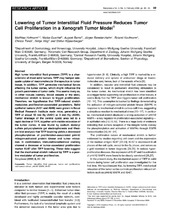Lowering of tumor interstitial fluid pressure reduces tumor cell proliferation in a xenograft tumor model
Hofmann, Matthias; Guschel, Maike; Bernd, August; Bereiter-Hahn, Jürgen; Kaufmann, Robert; Tandi, Christa; Wiig, Helge; Kippenberger, Stefan
Peer reviewed, Journal article
Published version
Permanent lenke
https://hdl.handle.net/1956/9790Utgivelsesdato
2006-02Metadata
Vis full innførselSamlinger
Originalversjon
https://doi.org/10.1593/neo.05469Sammendrag
High tumor interstitial fluid pressure (TIFP) is a characteristic of most solid tumors. TIFP may hamper adequate uptake of macromolecular therapeutics in tumor tissue. In addition, TIFP generates mechanical forces affecting the tumor cortex, which might influence the growth parameters of tumor cells. This seems likely as, in other tissues (namely, blood vessels or the skin), mechanical stretch is known to trigger proliferation. Therefore, we hypothesize that TIFP-induced stretch modulates proliferation-associated parameters. Solid epithelial tumors (A431 and A549) were grown in Naval Medical Research Institute nude mice, generating a TIFP of about 10 mm Hg (A431) or 5 mm Hg (A549). Tumor drainage of the central cystic area led to a rapid decline of TIFP, together with visible relaxation of the tumor cortex. It was found by sodium dodecyl sulfate polyacrylamide gel electrophoresis and Western blot analysis that TIFP lowering yields a decreased phosphorylation of proliferation-associated p44/42 mitogen-activated protein kinase and tumor relaxation. In confirmation, immunohistochemical staining showed a decrease of tumor-associated proliferation marker Ki-67 after TIFP lowering. These data suggest that the mechanical stretch induced by TIFP is a positive modulator of tumor proliferation.
Utgiver
ElsevierTidsskrift
NeoplasiaOpphavsrett
Copyright 2006 Neoplasia Press, Inc.
Med mindre annet er angitt, så er denne innførselen lisensiert som Attribution-NonCommercial-NoDerivs CC BY-NC-ND
Beslektede innførsler
Viser innførsler beslektet ved tittel, forfatter og emneord.
-
Hyperoxia increases the uptake of 5-fluorouracil in mammary tumors independently of changes in interstitial fluid pressure and tumor stroma
Moen, Ingrid; Tronstad, Karl Johan; Kolmannskog, Odd; Salvesen, Gerd Signe; Reed, Rolf K.; Stuhr, Linda Elin Birkhaug (Peer reviewed; Journal article, 2009-12-17)Background: Hypoxia is associated with increased resistance to chemo- and radiation-therapy. Hyperoxic treatment (hyperbaric oxygen) has previously been shown to potentiate the effect of some forms of chemotherapy, and ... -
Gene expression in tumor cells and stroma in dsRed 4T1 tumors in eGFP-expressing mice with and without enhanced oxygenation
Moen, Ingrid; Jevne, Alison Charlotte; Wang, Jian; Kalland, Karl-Henning; Chekenya, Martha; Akslen, Lars A.; Sleire, Linda; Enger, Per Øyvind; Reed, Rolf K.; Øyan, Anne Margrete; Stuhr, Linda Elin Birkhaug (Peer reviewed; Journal article, 2012-01-17)Background The tumor microenvironment is pivotal in tumor progression. Thus, we aimed to develop a mammary tumor model to elucidate molecular characteristics in the stroma versus the tumor cell compartment by global gene ... -
Elevated CD3+ and CD8+ tumor-infiltrating immune cells correlate with prolonged survival in glioblastoma patients despite integrated immunosuppressive mechanisms in the tumor microenvironment and at the systemic level
Kmiecik, Justyna; Poli, Aurélie; Brons, Nicolaas H.C.; Waha, Andreas; Eide, Geir Egil; Enger, Per Øyvind; Zimmer, Jacques; Chekenya, Martha (Peer reviewed; Journal article, 2013-11-15)We characterized GBM patients' tumor and systemic immune contexture with aim to reveal themechanisms of immunological escape, their impact on patient outcome, and identify targets for immunotherapy. Increased CD3+ T-cell ...

